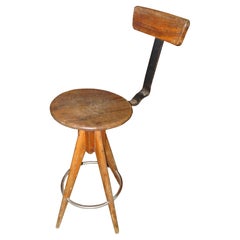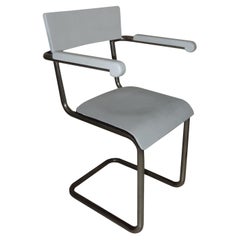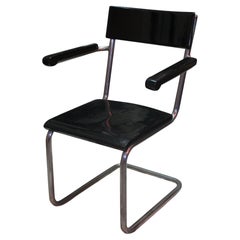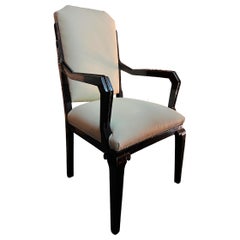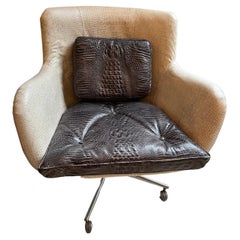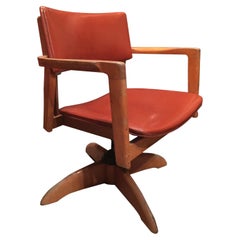Luxurydesignstore Seating
to
1
6
82
Height
to
Width
to
Depth
to
38
28
5
7
1
5
2
4
1
3
1
12
43
19
7
1
1
3
79
17
60
2
5
12
23
12
10
15
2
60
33
33
31
21
69
47
12
9
9
82
82
82
Stool in Wood, Country France, 1950
Located in Ciudad Autónoma Buenos Aires, C
Stools.
Material: iron and wood
You want to live in the golden years, this is the stool that your project needs.
We have specialized in the sale of Art Deco and Art Nouveau and Vin...
Category
Vintage 1950s French Space Age Stools
Materials
Iron
Armchair in Wood and Chrome, Style: Bauhaus, German, 1940
Located in Ciudad Autónoma Buenos Aires, C
Armchair
Wood and chrome
Year: 1940
Country: Germany
We have specialized in the sale of Art Deco and Art Nouveau and Vintage styles since 1982. If you have any questions we are at ...
Category
Vintage 1940s German Bauhaus Office Chairs and Desk Chairs
Materials
Chrome
Armchair in Wood and Chrome, Style: Bauhaus, German, 1940
Located in Ciudad Autónoma Buenos Aires, C
Armchair
Wood and chrome
Year: 1940
Country: Germany
If you are looking for a desk chair to match your desk, we have what you need.
We have specialized in the sale of Art Deco and...
Category
Vintage 1940s German Bauhaus Office Chairs and Desk Chairs
Materials
Chrome
Desk Chair in Leather and Wood, Style: Art Deco, France, 1930
Located in Ciudad Autónoma Buenos Aires, C
Art Deco Armchair
Wood and leather
Year: 1930
Country: France
If you are looking for a desk chair to match your desk, we have what you need.
We have specialized in the sale of Art ...
Category
Vintage 1930s French Art Deco Office Chairs and Desk Chairs
Materials
Wood, Leather
American Desk Armchair, 1970
Located in Ciudad Autónoma Buenos Aires, C
Armchair
Year: 1970
We have specialized in the sale of Art Deco and Art Nouveau and Vintage styles since 1982. If you have any questions we are at your disposal.
Pushing the button t...
Category
Vintage 1970s American Art Deco Office Chairs and Desk Chairs
Materials
Chrome
American Desk Armchair, 1950
Located in Ciudad Autónoma Buenos Aires, C
Art Deco desk chair
Wood
Year: 1950
If you are looking for a desk chair to match your desk, we have what you need.
We have specialized in the sale of Art Deco and Art Nouveau and Vintage styles since 1982.
Pushing the button that reads 'View All From Seller'. And you can see more objects to the style for sale.
Why are there so many antiques in Argentina?
In the 1880 – 1940 there was a grate wave of immigration encouraged by the periods of war that were taking place.
1st World War took place between 1914 and 1918
2nd World War took place between 1939 and 1945
The immigrants options were New York or Buenos Aires. Tickets were cheap and in Buenos Aires they were welcomed with open arms, as it was a country where everything was still to be done.
Argentina was the country of new opportunities, labour was needed and religious freedom was assured, in many cases the of the family travel first until they were settled and then the rest of the family members join them.
In the immigrant museum “Ellis Island Immigrant Building” in New York you can se the promotional posters of the boats that would take them to a new life.
Between the years 1895 and 1896, Argentina had the highest DGP (gross domestic product) per capita in the world according to the Maddison Historical Statistics index, this situation arose due to the large amount of food being exported to European countries, which were at war.
The Argentinean ships left the port of Buenos Aires with food, but they returned with furniture, clothes and construction elements, (it´s common to see this the old buildings of the historic neighbourhood of San Telmo, the beams with the inscription “Made in England)”, as well as many markets that were built in Buenos Aires, such us the San Telmo Market, whose structure was brought by ship and afterwards assembled in 900 Defensa Street.
With the great influence of European immigrants living in the country, the children of the upper classes travelled to study in France, resulting in the inauguration of “La Maison Argentinienne”, on 27th of June 1928, in the international city of Paris, which hosted many Argentinians that were studying in Frace.
It´s the fourth house to be built after France, Canada and Belgium, being the first Spanish-speaking one. Still in place today (17 Bd Jourdan, 75014, Paris, France). Many of the children of these wealthy families who attended international art exhibitions, museums and art courses abroad, took a keen interest in the European style. This is why Buenos Aires was at the time referred as “The Paris of South America”.
Between the years 1890 and 1920 more than a hundred Palaces were built on Alvear Avenue the most exclusive avenue in Buenos Aires. Today some of these palaces have been transformed into museums, hotels and embassies.
In the year 1936, the Kavanagh building was inaugurated, it was the tallest reinforced concrete building in South America.
During 1994 the American Society of Civil Engineers distinguished it as an “international engineering milestone”, and it´s now considered a World Heritage of Modern Architecture.
At the time was common to hire foreign architects such as Le Corbusier, who visited Buenos Aires/Argentina in 1929 and in 1948 he drew up the blueprints for a house built in La Plata City (which was declared a World Heritage Site).
In 1947, the Hungarian architect Marcelo Breuer designed “Parador Ariston” in the seaside city of Mar del Plata. After an Argentinean student at Harvard University convinced him to come to Argentina. He worked on an urban development project in the Casa Amarilla, area of La Boca.
The Ukrainian architect, Vladimiro Acosta, arrives in Argentina in 1928 and worked as an architect until que moved to Brazil.
Antonio Bonet, a Spanish architect who worked with Le Corbusier in Paris, arrives in Argentina in 1937, where he carried out several architectural works and in 1938 designs the well-known BFK chair...
Category
Vintage 1950s American Mid-Century Modern Office Chairs and Desk Chairs
Materials
Wood
Desk Chair Style: Art Deco, France, 1930
Located in Ciudad Autónoma Buenos Aires, C
Art Deco desk chair
Wood
Year: 1930
Country: France
If you are looking for a desk chair to match your desk, we have what you need.
We have specialized in the sale of Art Deco and Art Nouveau and Vintage styles since 1982.
Pushing the button that reads 'View All From Seller'. And you can see more objects to the style for sale.
Why are there so many antiques in Argentina?
In the 1880 – 1940 there was a grate wave of immigration encouraged by the periods of war that were taking place.
1st World War took place between 1914 and 1918
2nd World War took place between 1939 and 1945
The immigrants options were New York or Buenos Aires. Tickets were cheap and in Buenos Aires they were welcomed with open arms, as it was a country where everything was still to be done.
Argentina was the country of new opportunities, labour was needed and religious freedom was assured, in many cases the of the family travel first until they were settled and then the rest of the family members join them.
In the immigrant museum “Ellis Island Immigrant Building” in New York you can se the promotional posters of the boats that would take them to a new life.
Between the years 1895 and 1896, Argentina had the highest DGP (gross domestic product) per capita in the world according to the Maddison Historical Statistics index, this situation arose due to the large amount of food being exported to European countries, which were at war.
The Argentinean ships left the port of Buenos Aires with food, but they returned with furniture, clothes and construction elements, (it´s common to see this the old buildings of the historic neighbourhood of San Telmo, the beams with the inscription “Made in England)”, as well as many markets that were built in Buenos Aires, such us the San Telmo Market, whose structure was brought by ship and afterwards assembled in 900 Defensa Street.
With the great influence of European immigrants living in the country, the children of the upper classes travelled to study in France, resulting in the inauguration of “La Maison Argentinienne”, on 27th of June 1928, in the international city of Paris, which hosted many Argentinians that were studying in Frace.
It´s the fourth house to be built after France, Canada and Belgium, being the first Spanish-speaking one. Still in place today (17 Bd Jourdan, 75014, Paris, France). Many of the children of these wealthy families who attended international art exhibitions, museums and art courses abroad, took a keen interest in the European style. This is why Buenos Aires was at the time referred as “The Paris of South America”.
Between the years 1890 and 1920 more than a hundred Palaces were built on Alvear Avenue the most exclusive avenue in Buenos Aires. Today some of these palaces have been transformed into museums, hotels and embassies.
In the year 1936, the Kavanagh building was inaugurated, it was the tallest reinforced concrete building in South America.
During 1994 the American Society of Civil Engineers distinguished it as an “international engineering milestone”, and it´s now considered a World Heritage of Modern Architecture.
At the time was common to hire foreign architects such as Le Corbusier, who visited Buenos Aires/Argentina in 1929 and in 1948 he drew up the blueprints for a house built in La Plata City (which was declared a World Heritage Site).
In 1947, the Hungarian architect Marcelo Breuer designed “Parador Ariston” in the seaside city of Mar del Plata. After an Argentinean student at Harvard University convinced him to come to Argentina. He worked on an urban development project in the Casa Amarilla, area of La Boca.
The Ukrainian architect, Vladimiro Acosta, arrives in Argentina in 1928 and worked as an architect until que moved to Brazil.
Antonio Bonet, a Spanish architect who worked with Le Corbusier in Paris, arrives in Argentina in 1937, where he carried out several architectural works and in 1938 designs the well-known BFK chair...
Category
Vintage 1930s French Art Deco Office Chairs and Desk Chairs
Materials
Wood
4 Chair, Italian, 1950
Located in Ciudad Autónoma Buenos Aires, C
4 Chairs
Country: Italian
If you are looking for a desk chair to match your desk, we have what you need.
We have specialized in the sale of Art Deco and Art Nouveau and Vintage styles since 1982.If you have any questions we are at your disposal.
Pushing the button that reads 'View All From Seller'. And you can see more objects to the style.
Why are there so many antiques in Argentina?
In the 1880 – 1940 there was a grate wave of immigration encouraged by the periods of war that were taking place.
1st World War took place between 1914 and 1918
2nd World War took place between 1939 and 1945
The immigrants options were New York or Buenos Aires. Tickets were cheap and in Buenos Aires they were welcomed with open arms, as it was a country where everything was still to be done.
Argentina was the country of new opportunities, labour was needed and religious freedom was assured, in many cases the of the family travel first until they were settled and then the rest of the family members join them.
In the immigrant museum “Ellis Island Immigrant Building” in New York you can se the promotional posters of the boats that would take them to a new life.
Between the years 1895 and 1896, Argentina had the highest DGP (gross domestic product) per capita in the world according to the Maddison Historical Statistics index, this situation arose due to the large amount of food being exported to European countries, which were at war.
The Argentinean ships left the port of Buenos Aires with food, but they returned with furniture, clothes and construction elements, (it´s common to see this the old buildings of the historic neighbourhood of San Telmo, the beams with the inscription “Made in England)”, as well as many markets that were built in Buenos Aires, such us the San Telmo Market, whose structure was brought by ship and afterwards assembled in 900 Defensa Street.
With the great influence of European immigrants living in the country, the children of the upper classes travelled to study in France, resulting in the inauguration of “La Maison Argentinienne”, on 27th of June 1928, in the international city of Paris, which hosted many Argentinians that were studying in Frace.
It´s the fourth house to be built after France, Canada and Belgium, being the first Spanish-speaking one. Still in place today (17 Bd Jourdan, 75014, Paris, France). Many of the children of these wealthy families who attended international art exhibitions, museums and art courses abroad, took a keen interest in the European style. This is why Buenos Aires was at the time referred as “The Paris of South America”.
Between the years 1890 and 1920 more than a hundred Palaces were built on Alvear Avenue the most exclusive avenue in Buenos Aires. Today some of these palaces have been transformed into museums, hotels and embassies.
In the year 1936, the Kavanagh building was inaugurated, it was the tallest reinforced concrete building in South America.
During 1994 the American Society of Civil Engineers distinguished it as an “international engineering milestone”, and it´s now considered a World Heritage of Modern Architecture.
At the time was common to hire foreign architects such as Le Corbusier, who visited Buenos Aires/Argentina in 1929 and in 1948 he drew up the blueprints for a house built in La Plata City (which was declared a World Heritage Site).
In 1947, the Hungarian architect Marcelo Breuer designed “Parador Ariston” in the seaside city of Mar del Plata. After an Argentinean student at Harvard University convinced him to come to Argentina. He worked on an urban development project in the Casa Amarilla, area of La Boca.
The Ukrainian architect, Vladimiro Acosta, arrives in Argentina in 1928 and worked as an architect until que moved to Brazil.
Antonio Bonet, a Spanish architect who worked with Le Corbusier in Paris, arrives in Argentina in 1937, where he carried out several architectural works and in 1938 designs the well-known BFK chair...
Category
Vintage 1920s Italian Space Age Office Chairs and Desk Chairs
Materials
Wood
$4,000 / item
Pair of Solid Lucite Vanity Chair, 1940s
Located in Ciudad Autónoma Buenos Aires, C
Pair of solid lucite chairs
We have specialized in the sale of Art Deco and Art Nouveau and Vintage styles since 1982. If you have any questions we are at your disposal.
Pushing the button that reads 'View All From Seller'. And you can see more objects to the style for sale.
Why are there so many antiques in Argentina?
In the 1880 – 1940 there was a grate wave of immigration encouraged by the periods of war that were taking place.
1st World War took place between 1914 and 1918
2nd World War took place between 1939 and 1945
The immigrants options were New York or Buenos Aires. Tickets were cheap and in Buenos Aires they were welcomed with open arms, as it was a country where everything was still to be done.
Argentina was the country of new opportunities, labour was needed and religious freedom was assured, in many cases the of the family travel first until they were settled and then the rest of the family members join them.
In the immigrant museum “Ellis Island Immigrant Building” in New York you can se the promotional posters of the boats that would take them to a new life.
Between the years 1895 and 1896, Argentina had the highest DGP (gross domestic product) per capita in the world according to the Maddison Historical Statistics index, this situation arose due to the large amount of food being exported to European countries, which were at war.
The Argentinean ships left the port of Buenos Aires with food, but they returned with furniture, clothes and construction elements, (it´s common to see this the old buildings of the historic neighbourhood of San Telmo, the beams with the inscription “Made in England)”, as well as many markets that were built in Buenos Aires, such us the San Telmo Market, whose structure was brought by ship and afterwards assembled in 900 Defensa Street.
With the great influence of European immigrants living in the country, the children of the upper classes travelled to study in France, resulting in the inauguration of “La Maison Argentinienne”, on 27th of June 1928, in the international city of Paris, which hosted many Argentinians that were studying in Frace.
It´s the fourth house to be built after France, Canada and Belgium, being the first Spanish-speaking one. Still in place today (17 Bd Jourdan, 75014, Paris, France). Many of the children of these wealthy families who attended international art exhibitions, museums and art courses abroad, took a keen interest in the European style. This is why Buenos Aires was at the time referred as “The Paris of South America”.
Between the years 1890 and 1920 more than a hundred Palaces were built on Alvear Avenue the most exclusive avenue in Buenos Aires. Today some of these palaces have been transformed into museums, hotels and embassies.
In the year 1936, the Kavanagh building was inaugurated, it was the tallest reinforced concrete building in South America.
During 1994 the American Society of Civil Engineers distinguished it as an “international engineering milestone”, and it´s now considered a World Heritage of Modern Architecture.
At the time was common to hire foreign architects such as Le Corbusier, who visited Buenos Aires/Argentina in 1929 and in 1948 he drew up the blueprints for a house built in La Plata City (which was declared a World Heritage Site).
In 1947, the Hungarian architect Marcelo Breuer designed “Parador Ariston” in the seaside city of Mar del Plata. After an Argentinean student at Harvard University convinced him to come to Argentina. He worked on an urban development project in the Casa Amarilla, area of La Boca.
The Ukrainian architect, Vladimiro Acosta, arrives in Argentina in 1928 and worked as an architect until que moved to Brazil.
Antonio Bonet, a Spanish architect who worked with Le Corbusier in Paris, arrives in Argentina in 1937, where he carried out several architectural works and in 1938 designs the well-known BFK chair...
Category
Vintage 1940s American Space Age Office Chairs and Desk Chairs
Materials
Lucite
$12,000 / set
Desk Chair Style: Art Deco, France, 1920
Located in Ciudad Autónoma Buenos Aires, C
Art Deco desk chair
Country: France
If you are looking for a desk chair to match your desk, we have what you need.
We have specialized in the sale of Art Deco and Art Nouveau and Vintage styles since 1982. If you have any questions we are at your disposal.
Pushing the button that reads 'View All From Seller'. And you can see more objects to the style for sale.
Why are there so many antiques in Argentina?
In the 1880 – 1940 there was a grate wave of immigration encouraged by the periods of war that were taking place.
1st World War took place between 1914 and 1918
2nd World War took place between 1939 and 1945
The immigrants options were New York or Buenos Aires. Tickets were cheap and in Buenos Aires they were welcomed with open arms, as it was a country where everything was still to be done.
Argentina was the country of new opportunities, labour was needed and religious freedom was assured, in many cases the of the family travel first until they were settled and then the rest of the family members join them.
In the immigrant museum “Ellis Island Immigrant Building” in New York you can se the promotional posters of the boats that would take them to a new life.
Between the years 1895 and 1896, Argentina had the highest DGP (gross domestic product) per capita in the world according to the Maddison Historical Statistics index, this situation arose due to the large amount of food being exported to European countries, which were at war.
The Argentinean ships left the port of Buenos Aires with food, but they returned with furniture, clothes and construction elements, (it´s common to see this the old buildings of the historic neighbourhood of San Telmo, the beams with the inscription “Made in England)”, as well as many markets that were built in Buenos Aires, such us the San Telmo Market, whose structure was brought by ship and afterwards assembled in 900 Defensa Street.
With the great influence of European immigrants living in the country, the children of the upper classes travelled to study in France, resulting in the inauguration of “La Maison Argentinienne”, on 27th of June 1928, in the international city of Paris, which hosted many Argentinians that were studying in Frace.
It´s the fourth house to be built after France, Canada and Belgium, being the first Spanish-speaking one. Still in place today (17 Bd Jourdan, 75014, Paris, France). Many of the children of these wealthy families who attended international art exhibitions, museums and art courses abroad, took a keen interest in the European style. This is why Buenos Aires was at the time referred as “The Paris of South America”.
Between the years 1890 and 1920 more than a hundred Palaces were built on Alvear Avenue the most exclusive avenue in Buenos Aires. Today some of these palaces have been transformed into museums, hotels and embassies.
In the year 1936, the Kavanagh building was inaugurated, it was the tallest reinforced concrete building in South America.
During 1994 the American Society of Civil Engineers distinguished it as an “international engineering milestone”, and it´s now considered a World Heritage of Modern Architecture.
At the time was common to hire foreign architects such as Le Corbusier, who visited Buenos Aires/Argentina in 1929 and in 1948 he drew up the blueprints for a house built in La Plata City (which was declared a World Heritage Site).
In 1947, the Hungarian architect Marcelo Breuer designed “Parador Ariston” in the seaside city of Mar del Plata. After an Argentinean student at Harvard University convinced him to come to Argentina. He worked on an urban development project in the Casa Amarilla, area of La Boca.
The Ukrainian architect, Vladimiro Acosta, arrives in Argentina in 1928 and worked as an architect until que moved to Brazil.
Antonio Bonet, a Spanish architect who worked with Le Corbusier in Paris, arrives in Argentina in 1937, where he carried out several architectural works and in 1938 designs the well-known BFK...
Category
Vintage 1920s French Art Deco Office Chairs and Desk Chairs
Materials
Wood
Art Nouveau Set, 1 Sofa, 2 Armchairs, 1900, France
Located in Ciudad Autónoma Buenos Aires, C
Incredible Art Nouveau Game.
The price includes the 3 armchairs
1 Sofa
2 Armchairs
Material: Wood, reupholstered with springs and elastic band (as it was in the old days)
We have specialized in the sale...
Category
Antique Early 1900s French Art Nouveau Armchairs
Materials
Wood
Art Deco Stool, Material Wood, Country France, 1930
Located in Ciudad Autónoma Buenos Aires, C
Stools Art Deco.
Material: wood
You want to live in the golden years, this is the stool that your project needs.
We have specialized in the sale of Art Deco and Art Nouveau style...
Category
Vintage 1930s French Art Deco Stools
Materials
Wood
Child seat ( Attributed Wilhelm Schmidt For Prag- Rudniker ) 1887, Prague
Located in Ciudad Autónoma Buenos Aires, C
Chair Jugendstil, Art Nouveau, Liberty
Material: Wood
Country:France
We have specialized in the sale of Art Deco and Art Nouveau and Vintage styles since 1982.If you have any questions we are at your disposal.
Pushing the button that reads 'View All From Seller'. And you can see more objects to the style for sale.
rag-Rudniker Korbwaren-Fabrication (Basketwork Factory)
The „Prag-Rudniker Korbwaren-Fabrication” had its origins in 1877 in Rudnik (Galicia), where Ferdinand Ernst Count Hompesch established a wickerwork school. Distribution of the products was done by the Prague merchants Karl and...
Category
Antique 1880s Czech Art Nouveau Chairs
Materials
Wood, Wicker
2 Armchairs Art Deco, France, 1920
Located in Ciudad Autónoma Buenos Aires, C
2 Armchairs Art Deco
Year 1920
Materials : Wood
Country: French
Elegant and sophisticated armchairs.
You want to live in the golden years, these a...
Category
Vintage 1920s French Art Deco Armchairs
Materials
Wood
$29,500 / set
8 Chairs , 1950, Country: Italy, Material: Wood
Located in Ciudad Autónoma Buenos Aires, C
6 chairs
Material: Wood
Country: italian
Year: 1950
We have specialized in the sale of Art Deco and Art Nouveau and Vintage styles since 1982.If you have any questions we are at you...
Category
Vintage 1950s Italian Space Age Windsor Chairs
Materials
Wood
2 Lounge Chairs, Year: 1967, Design: Horacio Baliero, Argentine Designer
Located in Ciudad Autónoma Buenos Aires, C
2 Lounge chairs " Chair Madrid"
year: 1967
Design: Architect Horacio Baliero and Justo Solsona
Argentine Designer
Material: Leather and Chrome
It was exhibited at the Museum of Arc...
Category
Vintage 1970s Argentine Space Age Lounge Chairs
Materials
Chrome
Chaise Longues Style Art Deco, Year 1930, Country: France, Wood and Mirror
Located in Ciudad Autónoma Buenos Aires, C
Chaise Longues
Style :Art deco
Year : 1930
Country: France
Materials: wood and mirror
We have specialized in the sale of Art Deco and Art Nouveau and Vintage styles since 1982.If ...
Category
Vintage 1930s French Art Deco Chaise Longues
Materials
Mirror, Wood
2 Amaizing Art Deco Stool in Leather and Wood, France, 1940
Located in Ciudad Autónoma Buenos Aires, C
2 stools Art Deco
Material: leather and wood
You want to live in the golden years, this is the stool that your project needs.
We have specialized in the sale of Art Deco and Art N...
Category
Vintage 1940s French Art Deco Stools
Materials
Leather, Wood
Desk Chair Style: Art Deco, France, Material Wood and Leather, 1930
Located in Ciudad Autónoma Buenos Aires, C
Art Deco desk chair
Material: leather and wood
Year: 1930
Country: France
If you are looking for a desk chair to match your desk, we have what you nee...
Category
Vintage 1930s French Art Deco Office Chairs and Desk Chairs
Materials
Leather, Wood
Desk Chair for the King, Style: Art Deco, 1930, German
Located in Ciudad Autónoma Buenos Aires, C
Art Deco desk chair
Material: leather and wood
Year: 1930
Country: Germany
If you are looking for a desk chair to match your desk, we have what you ne...
Category
Vintage 1930s German Art Deco Armchairs
Materials
Leather, Wood
2 Armchairs in Leather 'Attributed to Paolo Buffa'
By Paolo Buffa
Located in Ciudad Autónoma Buenos Aires, C
2 armchairs in leather "Attributed to Paolo Buffa"
Year 1960
Materials : Wood and leather
Finish: polyurethanic lacquer
Country: Italian
Elegant and sophisticated armchairs.
We have specialized in the sale of Art Deco and Art Nouveau and Vintage styles since 1982.If you have any questions we are at your disposal.
Pushing the button that reads 'View All From Seller'. And you can see more objects to the style for sale.
Paolo Buffa was an Italian architect and designer best known for his designs of mid-century furniture. Characterized by a melding of tradition and modernity, he used a combination of low-profile, rectilinear, and hardwood forms to produce his most classic pieces. Born in 1903 in Milan, Italy, Buffa studied at the Polytechnic Institute of Milan before working for the prominent Italian architect and designer Gio Ponti. After opening a firm with his frequent collaborator Antonio Cassi Ramelli...
Category
Vintage 1960s Italian Mid-Century Modern Armchairs
Materials
Leather, Wood
$12,000 / set
Pair of African Chairs, King's Seat
Located in Ciudad Autónoma Buenos Aires, C
Chairs in wood
year: 1940
The quality of the chairs and the exotic wood used they make them unique. It is an icon of distinction.
Hehe
Carving elegant legged stool, are considered e...
Category
Vintage 1940s Tanzanian Tribal Chairs
Materials
Wood
$230,000 / set
